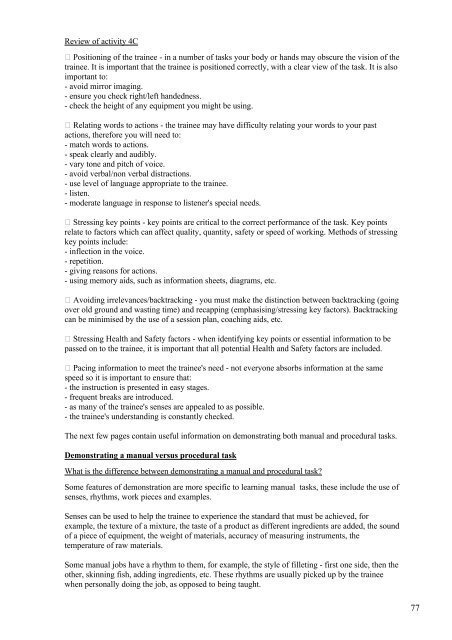How to Perform On-the-job Training - Dean Amory
According to The Encyclopedia of Business, ©2000 Gale Cengage, On-the-job training is by far the predominant form of job training. Studies also indicate that it is the most effective form of job training. Yet, it also represents a significant investment considering that roughly 30% of a new worker's time is spent in on-the-job training during the first 90 days of employment, that productivity of experienced workers assigned to train new workers may decrease during the training period, and that new workers may make expensive mistakes. Both companies and workers therefore profit largely from the presence of simple, but complete trainee and trainer guides that allow for executing OJT in a structured way. “How to perform on-the-job training”, has the information, techniques and tips that will allow you to implement a professional OJT training program. The book also includes all the tools, documents and checklists necessary for setting up a qualitative and efficient skills training program for OJT coaches
According to The Encyclopedia of Business, ©2000 Gale Cengage, On-the-job training is by far the predominant form of job training. Studies also indicate that it is the most effective form of job training. Yet, it also represents a significant investment considering that roughly 30% of a new worker's time is spent in on-the-job training during the first 90 days of employment, that productivity of experienced workers assigned to train new workers may decrease during the training period, and that new workers may make expensive mistakes.
Both companies and workers therefore profit largely from the presence of simple, but complete trainee and trainer guides that allow for executing OJT in a structured way.
“How to perform on-the-job training”, has the information, techniques and tips that will allow you to implement a professional OJT training program. The book also includes all the tools, documents and checklists necessary for setting up a qualitative and efficient skills training program for OJT coaches
Create successful ePaper yourself
Turn your PDF publications into a flip-book with our unique Google optimized e-Paper software.
Review of activity 4C<br />
Positioning of <strong>the</strong> trainee - in a number of tasks your body or hands may obscure <strong>the</strong> vision of <strong>the</strong><br />
trainee. It is important that <strong>the</strong> trainee is positioned correctly, with a clear view of <strong>the</strong> task. It is also<br />
important <strong>to</strong>:<br />
- avoid mirror imaging.<br />
- ensure you check right/left handedness.<br />
- check <strong>the</strong> height of any equipment you might be using.<br />
Relating words <strong>to</strong> actions - <strong>the</strong> trainee may have difficulty relating your words <strong>to</strong> your past<br />
actions, <strong>the</strong>refore you will need <strong>to</strong>:<br />
- match words <strong>to</strong> actions.<br />
- speak clearly and audibly.<br />
- vary <strong>to</strong>ne and pitch of voice.<br />
- avoid verbal/non verbal distractions.<br />
- use level of language appropriate <strong>to</strong> <strong>the</strong> trainee.<br />
- listen.<br />
- moderate language in response <strong>to</strong> listener's special needs.<br />
Stressing key points - key points are critical <strong>to</strong> <strong>the</strong> correct performance of <strong>the</strong> task. Key points<br />
relate <strong>to</strong> fac<strong>to</strong>rs which can affect quality, quantity, safety or speed of working. Methods of stressing<br />
key points include:<br />
- inflection in <strong>the</strong> voice.<br />
- repetition.<br />
- giving reasons for actions.<br />
- using memory aids, such as information sheets, diagrams, etc.<br />
Avoiding irrelevances/backtracking - you must make <strong>the</strong> distinction between backtracking (going<br />
over old ground and wasting time) and recapping (emphasising/stressing key fac<strong>to</strong>rs). Backtracking<br />
can be minimised by <strong>the</strong> use of a session plan, coaching aids, etc.<br />
Stressing Health and Safety fac<strong>to</strong>rs - when identifying key points or essential information <strong>to</strong> be<br />
passed on <strong>to</strong> <strong>the</strong> trainee, it is important that all potential Health and Safety fac<strong>to</strong>rs are included.<br />
Pacing information <strong>to</strong> meet <strong>the</strong> trainee's need - not everyone absorbs information at <strong>the</strong> same<br />
speed so it is important <strong>to</strong> ensure that:<br />
- <strong>the</strong> instruction is presented in easy stages.<br />
- frequent breaks are introduced.<br />
- as many of <strong>the</strong> trainee's senses are appealed <strong>to</strong> as possible.<br />
- <strong>the</strong> trainee's understanding is constantly checked.<br />
The next few pages contain useful information on demonstrating both manual and procedural tasks.<br />
Demonstrating a manual versus procedural task<br />
What is <strong>the</strong> difference between demonstrating a manual and procedural task?<br />
Some features of demonstration are more specific <strong>to</strong> learning manual tasks, <strong>the</strong>se include <strong>the</strong> use of<br />
senses, rhythms, work pieces and examples.<br />
Senses can be used <strong>to</strong> help <strong>the</strong> trainee <strong>to</strong> experience <strong>the</strong> standard that must be achieved, for<br />
example, <strong>the</strong> texture of a mixture, <strong>the</strong> taste of a product as different ingredients are added, <strong>the</strong> sound<br />
of a piece of equipment, <strong>the</strong> weight of materials, accuracy of measuring instruments, <strong>the</strong><br />
temperature of raw materials.<br />
Some manual <strong>job</strong>s have a rhythm <strong>to</strong> <strong>the</strong>m, for example, <strong>the</strong> style of filleting - first one side, <strong>the</strong>n <strong>the</strong><br />
o<strong>the</strong>r, skinning fish, adding ingredients, etc. These rhythms are usually picked up by <strong>the</strong> trainee<br />
when personally doing <strong>the</strong> <strong>job</strong>, as opposed <strong>to</strong> being taught.<br />
77


















